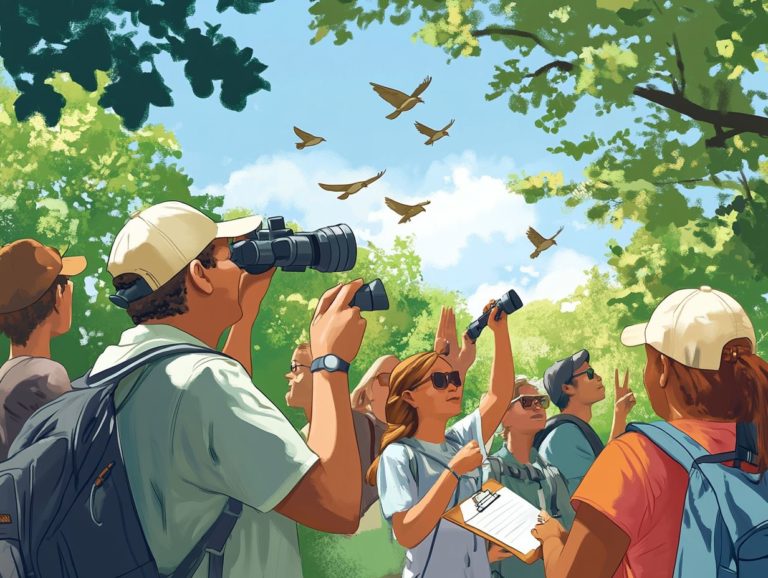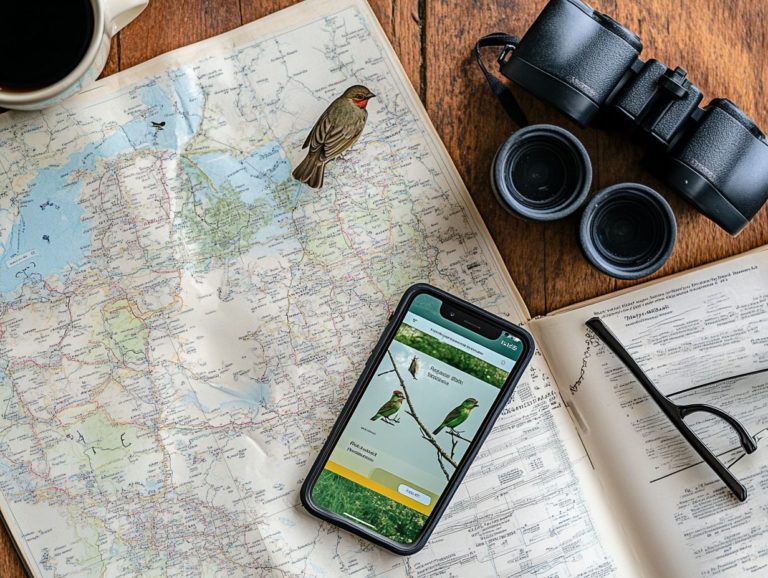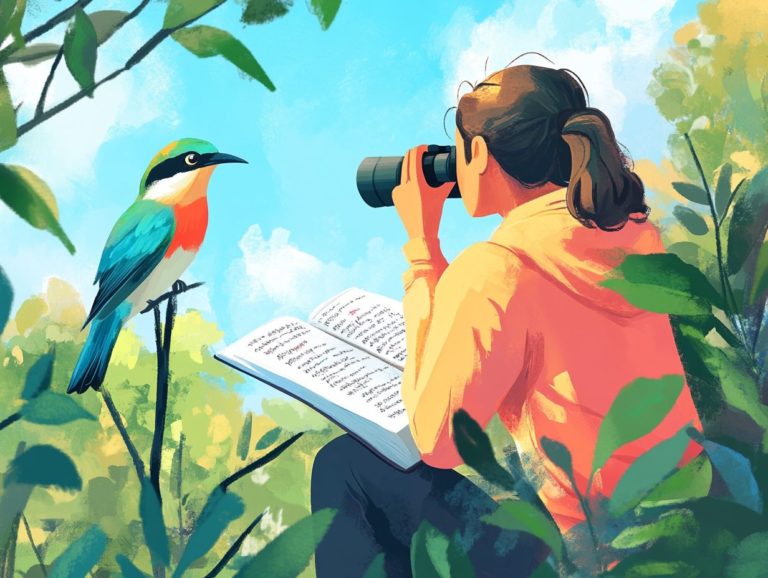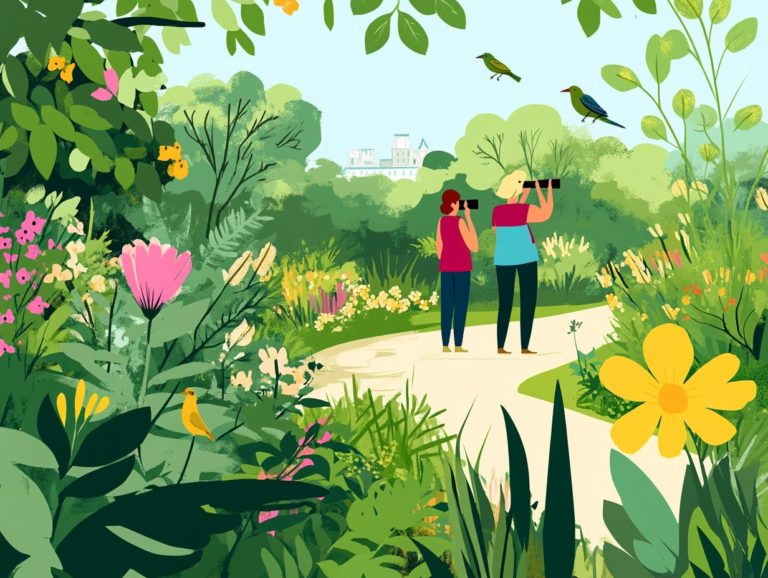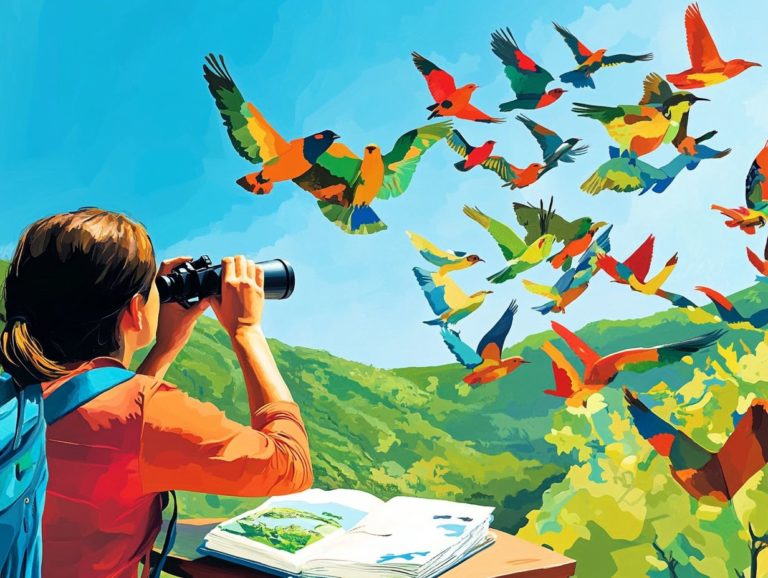How Do I Avoid Scaring Birds While Observing Them?
Birdwatching is an exhilarating adventure that opens up a world of wonder. However, it carries the responsibility of observing without causing distress to our feathered friends. Understanding why birds become frightened is essential for any aspiring birdwatcher.
Discover simple techniques to observe birds without startling them! This article shares effective methods for selecting the ideal location and minimizing noise and movement. It also recommends essential equipment for a successful outing and best practices for interacting with birds.
Whether you are a seasoned observer or a curious beginner, these insights will enhance your experience and deepen your connection with nature.
Contents
- Key Takeaways:
- Understanding Bird Behavior
- Choosing the Right Location
- Techniques for Observing Birds Without Scaring Them
- Equipment for Bird Observation
- Other Helpful Tools and Accessories
- Tips for Interacting with Birds
- Frequently Asked Questions
- Want to Capture Birds Without Scaring Them? Here’s How!
- What Should I Wear When Bird Watching to Avoid Scaring Them While Practicing Natural Photography?
- Can I Use Binoculars or a Camera Without Scaring the Birds During Bird Photography?
- How can I avoid scaring birds while setting up my equipment?
- What Should I Do If a Bird Gets Scared While I Am Watching It During Bird Photography?
- Are There Any Specific Times of Day that are Better for Bird Watching While Practicing Bird Photography?
Key Takeaways:
Understanding Bird Behavior
To capture stunning photos, knowing bird behavior is key. Various factors, including natural instincts and learned behaviors, influence how birds act, which can be recognized through diligent observation.
By understanding these behaviors, photographers can develop strategies to minimize disturbances during close encounters. This creates optimal conditions for photographing species like the Savannah Sparrow and Great Gray Owl without causing them to take flight.
Why Birds Get Scared
Birds can easily become frightened by various environmental disturbances, such as the sudden appearance of their natural predators. This triggers their instinctual flight response. For bird photographers aiming to capture natural images, understanding these reactions is essential.
Many birds rely on their sharp eyesight and good hearing to detect potential threats in their environment. Loud noises, sudden movements, or unfamiliar objects can increase their stress levels and prompt them to flee in search of safety.
To minimize these disturbances and enhance the chances of capturing compelling images, photographers can use tools like bird-repelling kites to simulate predators or motion-activated sprinklers that produce startling sounds without causing harm. By employing these techniques—aligned with bird behavior and conducive to maintaining natural environments—photographers can observe species such as the American Robin or the Great Blue Heron without causing undue fear.
Choosing the Right Location
Location plays a crucial role in bird photography. Different environments, such as urban areas or wildlife refuges, significantly influence the types of birds that can be observed engaging in their natural behaviors. Ideal locations enhance visibility and facilitate extended periods of observation, allowing photographers to capture stunning images without disturbing the birds.
Factors such as the availability of diverse habitats—from wetlands teeming with waterfowl to forests inhabited by songbirds—are vital for attracting a wide range of species. For instance, the Everglades in Florida are renowned for their rich variety of birds, including herons and migrating ducks, thanks to the presence of wetlands.
Coastal areas like Point Reyes in California provide opportunities to observe seabirds and shorebirds due to their unique marine environments. Accessibility is also key; locations that are easy to navigate allow for more time spent observing rather than traveling.
Being aware of seasonal migrations enhances the birdwatching experience. Many birders find that certain locations are particularly rewarding at different times of the year.
Techniques for Observing Birds Without Scaring Them
Mastering the art of observing birds without startling them is crucial for any aspiring bird photographer. This skill allows for capturing images of birds in close proximity while they engage in natural behaviors.
Techniques such as moving slowly and deliberately, along with understanding the patience levels of different bird species, significantly enhance the chances of a successful shoot while minimizing disturbances that could scare the birds away.
Using Disguises and Hiding Techniques
Disguises and hiding techniques can significantly enhance bird photography. These methods enable photographers to blend into their surroundings and observe birds without being detected. Techniques range from utilizing natural cover to employing specialized gear, allowing for patient observation while minimizing movements that might startle birds.
To improve their camouflage, bird photographers often use materials like camouflage netting. This helps cover equipment and gear, breaking up outlines against the foliage. Earth-toned clothing also aids in blending in, as bright hues can disrupt the natural color palette.
Photographers can also use natural materials such as branches or leaves to create makeshift blinds. Crouching low can help you sneak up on birds for incredible close-ups, allowing for closer and more intimate shots of avian subjects without interruption.
Minimizing Noise and Movement
Reducing noise and movement is essential for successful bird photography. Birds can easily become frightened and may fly away at the slightest disturbance. By minimizing sound and movement, photographers show respect for the birds and capture more authentic representations of avian life.
Using quieter equipment, like lenses with image stabilization and features that help the camera focus quickly on birds, can reduce noise during shutter release. Move slowly and deliberately; even sudden movements can startle birds. Different habitats require tailored approaches; for instance, dense woodlands demand different techniques than open fields.
In these rich ecosystems, remaining still and allowing birds to acclimate to your presence can yield rewarding results. Seize the moment!
Equipment for Bird Observation
Bird observation equipment enhances photography by ensuring high-quality images of birds in their natural habitats. This allows for accurate documentation of their behaviors and interactions.
Recommended binoculars, cameras, and other accessories can significantly improve the bird photography experience and facilitate the application of effective photography techniques.
Recommended Binoculars and Cameras
Bird photography involves capturing images of birds in their natural habitats. The right binoculars and camera can help photographers take stunning photographs of various species, especially shy or elusive ones.
Among the best cameras for bird photography is the Canon EOS-1D X Mark II. It’s perfect for capturing fast-moving birds due to its quick shooting speed and excellent autofocus. Birdwatching binoculars are essential for enthusiasts, allowing them to identify birds and observe their behavior before reaching for a camera.
The Nikon D500 is another outstanding choice, offering quick shooting capabilities and impressive focusing features, making it ideal for fast-moving subjects.
For binoculars, the Swarovski EL 12×42 stands out due to its exceptional clarity and brightness. This allows users to spot even the most camouflaged birds from a considerable distance. The best binoculars not only enhance photography but also enrich the overall birdwatching experience.
Top birdwatching cameras and binoculars can cost anywhere from $1,500 to $6,000, but don’t worry; there are budget-friendly options that still deliver amazing results!
Have you ever experienced the thrill of capturing a bird in flight? Explore bird photography and invest in quality equipment to elevate your experience!
Other Helpful Tools and Accessories
Along with cameras and binoculars, various tools and accessories enhance bird observation and facilitate effective bird photography techniques.
One category of these products includes motion-activated sprinklers and bird deterrent lasers, which help reduce disturbances. These products create a more conducive environment for photographing birds. For instance, bird-repelling kites that mimic predators foster a safe space where birds feel less threatened. This allows for more natural behaviors to be captured.
Ultrasonic repellents, which emit sound waves imperceptible to humans, can gently encourage unwanted species to vacate without disrupting the area’s tranquility. Portable blinds offer photographers shelter from the elements and provide camouflage while they wait to capture the perfect moment.
These innovations are crucial for creating an environment where both observers and the magnificent creatures that grace the skies can thrive. Ultimately, this leads to more beautiful and intimate wildlife photography.
Tips for Interacting with Birds
Interacting with birds during photography necessitates patience and a deep respect for their natural behaviors. Photographers should adhere to best practices to create positive experiences for both the birds and themselves.
By doing so, they can enhance the quality of their photographs while keeping the birds undisturbed.
Best Practices for Interacting with Birds in Natural Photography
Best practices for interacting with birds are essential for any bird photographer. These recommendations ensure a beneficial experience for both the photographer and the birds.
Techniques such as patient observation and recognizing bird behaviors enable photographers to approach without causing undue stress.
Ethical photography plays a significant role in this relationship, as it encourages photographers to capture images without disturbing the natural environment of their avian subjects. Maintaining an appropriate distance is crucial. This protects the birds from unnecessary stress and fosters a natural setting for striking images.
Understanding bird behavior can greatly enhance your interaction. Recognizing signs of stress or comfort gives the power to photographers to make informed decisions.
Responsible photography practices not only enrich the experience for photographers but also help maintain the delicate balance of wildlife ecosystems.
Common Mistakes in Bird Photography to Avoid
Avoid common mistakes in bird photography to capture stunning images and protect our feathered friends! The most frequent errors include:
- Approaching too quickly.
- Failing to recognize signs of distress in the birds.
- Making poor lighting choices.
These mistakes can lead to missed opportunities and adversely affect bird behavior. Photographers often underestimate the importance of maintaining a safe distance from their subjects. This oversight can cause birds to abandon their nests or stop feeding their young.
Poor lighting choices can also result in images that are too dark or too washed out, ultimately ruining the shot. To make every shot count, steer clear of these common errors! By being more mindful of pitfalls—such as using long-range lenses designed for close-up shots to capture images from a distance and waiting for optimal lighting—aspiring bird photographers can enhance their skills and foster a more respectful relationship with their avian subjects.
This awareness transforms every outing from merely a photo opportunity into a chance for observation and appreciation, especially when it includes learning about bird behavior.
Frequently Asked Questions
Want to Capture Birds Without Scaring Them? Here’s How!
To avoid scaring birds while observing them, try to blend in with your surroundings and avoid sudden movements or loud noises. Keep a safe distance and approach birds slowly and quietly.
What Should I Wear When Bird Watching to Avoid Scaring Them While Practicing Natural Photography?
It is best to wear neutral colors that blend in with the environment, such as khaki or brown. Avoid bright colors or busy patterns that may startle birds.
Can I Use Binoculars or a Camera Without Scaring the Birds During Bird Photography?
Yes, you can use binoculars or a camera to observe birds from a safe distance without disturbing them. Just be sure to move slowly and avoid sudden movements.
Start applying these tips today to elevate your bird photography!
How can I avoid scaring birds while setting up my equipment?
Find a safe spot to watch birds without disturbing them. Stay clear of their nests and feeding areas.
What Should I Do If a Bird Gets Scared While I Am Watching It During Bird Photography?
Back away slowly if a bird gets scared. Respecting the bird’s space is crucial to avoid stress.
Are There Any Specific Times of Day that are Better for Bird Watching While Practicing Bird Photography?
Early mornings and late afternoons are the best times for bird watching. Birds are more active then and less likely to be disturbed.

